
An AIEL Instructional

Tech Tips
|
The Kits section aside, here are some accessories and ideas that will assist at any show or event. |
THE FOLLOWING MAY NOT BE REPRODUCED
WITHOUT PERMISSION FROM THE AUTHOR ©
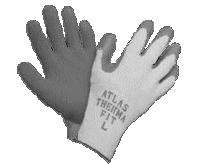 These are made from a thin material with rubber-like palm and finger
facings. I originally bought them for loading and unloading but found that
I could focus hot lights with no discomfort. Because they are thin, I have
dexterity -- a plus, of course, when manipulating lighting instruments.
They are insulated well enough that the facings will begin to soften before
I feel discomfort from heat. Service life is good, as well, with me seeing
about three seasons from a pair.
These are made from a thin material with rubber-like palm and finger
facings. I originally bought them for loading and unloading but found that
I could focus hot lights with no discomfort. Because they are thin, I have
dexterity -- a plus, of course, when manipulating lighting instruments.
They are insulated well enough that the facings will begin to soften before
I feel discomfort from heat. Service life is good, as well, with me seeing
about three seasons from a pair.
 The belt assembly consists of a large stationery binder clip and a
snap (spring) hook. (Also known as a `snaplink'.) The binder clip is the
type with broad clamps and finger grasps that can fold flat. The snaphook
is the style with a sharp-edged closure that digs into my belt. As such,
it can never slip off. Simply clip the snaphook on to one of the binder
clip's grasps. If the snaphook has an enclosed ring, join the two together
by removing one of the binder clip's finger grasps. Do this by squeezing
the side of one of the grasps toward the other until the bent ends are
free of the clamp. Now slip it through the snaphook's ring and then
replace the bent ends back into the clip.
The belt assembly consists of a large stationery binder clip and a
snap (spring) hook. (Also known as a `snaplink'.) The binder clip is the
type with broad clamps and finger grasps that can fold flat. The snaphook
is the style with a sharp-edged closure that digs into my belt. As such,
it can never slip off. Simply clip the snaphook on to one of the binder
clip's grasps. If the snaphook has an enclosed ring, join the two together
by removing one of the binder clip's finger grasps. Do this by squeezing
the side of one of the grasps toward the other until the bent ends are
free of the clamp. Now slip it through the snaphook's ring and then
replace the bent ends back into the clip.
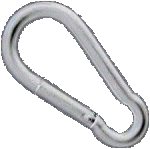 After clamping the gloves to one's belt, the outer grasp is folded
downward to lie against them, meaning it is not sticking out where it
might get bent or pulled off while one is working.
After clamping the gloves to one's belt, the outer grasp is folded
downward to lie against them, meaning it is not sticking out where it
might get bent or pulled off while one is working.
I made this assembly because I was tired of continually seeking out the last place in which I had laid down my gloves during setups. The effort spent clipping and unclipping them from my belt more than makes up for the time I once lost searching for errant gloves.
For more information, see
Purchase Guide: Work Gloves.
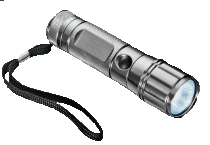 This is another item I always want with me at all times. Laying down
one's gloves is one thing, but leaving a flashlight means almost assured
loss. For my work, I used to use a flashlight with an incandescent
light source, a thumb-operable, push-button switch, and a battery type of
two, AA alkaline cells. I wanted a white colour of light with good shielding
of spill and a pre-focused reflector to give me a defined, round beam
without being too bright for backstage usage. Now I use an LED model with
lithium cells. (View the Update at the end of this section.)
This is another item I always want with me at all times. Laying down
one's gloves is one thing, but leaving a flashlight means almost assured
loss. For my work, I used to use a flashlight with an incandescent
light source, a thumb-operable, push-button switch, and a battery type of
two, AA alkaline cells. I wanted a white colour of light with good shielding
of spill and a pre-focused reflector to give me a defined, round beam
without being too bright for backstage usage. Now I use an LED model with
lithium cells. (View the Update at the end of this section.)
The double `A' cells give me good life but with a reasonably sized flashlight barrel because their diameter is less than 15mm. Plus the alkalines give me confidence that I won't have the dreaded rechargeable battery "dip to zero" in the middle of a show. Rechargeable batteries tend to have a steep discharge slope. Once they start to drop voltage, the end comes quickly. Alkalines, on the other hand, have a long, shallow voltage-drop curve. Plus, they have a long shelf life. Rechargeables are likely to have low or no voltage after some time in a case and thus have to be recharged before a show.
I selected a push-button switch so I won't have to focus the light to turn it on and defocus it to turn it off. Plus, if you can find one with a make-before-lock switch, you will have momentary light for those quick flashes of illumination.
The belt clip uses the same model snaphook as for the gloves. The chosen flashlight must have a loop to attach to the clip, or preferably a rigid ring as opposed to a cord or lanyard. The ring will keep the light in an orientation at one's side that immediately places one's thumb on the switch as soon as the light is grasped. Realise that a quick link may be required to mate the loop on the clip with the one on the light.
UPDATE!
Over the past decade I have tried LED flashlights, but had to
heat shrink the barrels to shield the spill. Today however,
there are a good variety of LED models that exhibit less
spill and give a reasonable, white light. As such, I now
employ a robust, aluminum flashlight with a single,
recessed LED. It has all the other features I like
except for no make-before-lock switch. I also
switched to lithium `AA' cells because they
last so long. This combination is currently
my first choice for a gig flashlight.
For more information, go to the
Purchase Guide: Flashlights.
This is only necessary if you use a lot of tape during a setup. Typically, a toilet-paper dispenser will hold a roll or three -- perhaps one of masking, one electrical and the other of stage (gaffer) tape. Stage managers might want to substitute spike or glow tape for the first two. (See our Purchase Guide: Adhesive Tapes.)
Get a slim, non-recessed, paper holder that can be modified or adapted to a belt clip. You may choose to have a clip on each end to keep the orientation of the holder parallel to your body as opposed to it twisting every time you take a step.
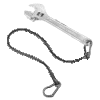
![]() (Yes I know: You are running out of belt space!) If you frequently
use a wrench to mount or focus lights, you might consider a lanyard to
keep from having to pocket the tool between uses. As well, this prevents
the wrench from falling farther than its tether length. Use a thin, soft,
flexible cord such as sash cord (available from us). Make it long enough
to run the distance from your belt to your farthest reach. Alternatively,
buy a small belt-mountable pocket or tool pouch to hold the wrench.
(See next.) Note that having a very long tether will mean having to
pocket or pouch your wrench because it will hang too low when not in hand.
(Yes I know: You are running out of belt space!) If you frequently
use a wrench to mount or focus lights, you might consider a lanyard to
keep from having to pocket the tool between uses. As well, this prevents
the wrench from falling farther than its tether length. Use a thin, soft,
flexible cord such as sash cord (available from us). Make it long enough
to run the distance from your belt to your farthest reach. Alternatively,
buy a small belt-mountable pocket or tool pouch to hold the wrench.
(See next.) Note that having a very long tether will mean having to
pocket or pouch your wrench because it will hang too low when not in hand.

![]() If your belt is getting full of separate items, consider a dedicated
tool holder that mounts to your belt -- or is the belt. Get a flexible one
with the number of pockets or loops required, plus a couple extra. Don't
buy a huge belt; it may look impressive but will be cumbersome when climbing,
especially in tight spaces.
If your belt is getting full of separate items, consider a dedicated
tool holder that mounts to your belt -- or is the belt. Get a flexible one
with the number of pockets or loops required, plus a couple extra. Don't
buy a huge belt; it may look impressive but will be cumbersome when climbing,
especially in tight spaces.
![]()
![]() An alternative to a tool belt is a waist wallet. This will suffice
if you want something smaller in size and have only few, small items
to carry. Get one with strong belt material and a quality snap-buckle.
Have the pocket sizes be suitable to hold the required tools, and be
sure the material is durable enough to withstand sharp points. If not,
have canvas or denim inserts sewn in.
An alternative to a tool belt is a waist wallet. This will suffice
if you want something smaller in size and have only few, small items
to carry. Get one with strong belt material and a quality snap-buckle.
Have the pocket sizes be suitable to hold the required tools, and be
sure the material is durable enough to withstand sharp points. If not,
have canvas or denim inserts sewn in.
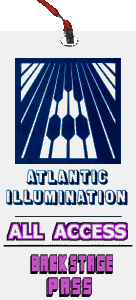
![]() This likely goes without saying, and any professional or
semi-professional will probably already have a Pass/Identification (ID).
However, if you have been relying on employers to provide them, it's
still a good idea to have one dedicated to yourself for usage at smaller
events, and as an addition to the one provided for larger shows.
This likely goes without saying, and any professional or
semi-professional will probably already have a Pass/Identification (ID).
However, if you have been relying on employers to provide them, it's
still a good idea to have one dedicated to yourself for usage at smaller
events, and as an addition to the one provided for larger shows.
It identifies you personally to any security officers, crew, promoter, performers and so on. Include your name, as it makes you better known to all. A recent, clear head-shot photo is a plus as well. If you generally do only one job, your title or job description might be included. There is a pleasing assurance to those that don't know you when you wear a comprehensive ID. It also presents an air of professionalism to those that see you, and is a form of subtle self promotion. (Just be sure that you live up to that promotion.) (-:
Make your pass/ID be one size larger than a standard business card -- say 60mm X 100mm. Any smaller makes it hard to discern, especially when it's dark; too much larger and it tends to get in the way while you work. The lanyard should be short so that the pass doesn't droop too far when you bend over. Be sure that the attachment point is reenforced as it will wear or tear with usage. This could result in a lost pass.
Put a duplicate pass back-to-back with the first so that no matter which way the lanyard turns, the information will be visible. Laminate the two so as to bond them together. This will give the pass durability and longevity. Make up two spares -- one to have in your wallet or gig case, another filed away at home. If you lose one, employ one of your spares, but replace the lost one as soon as possible.
Finally, consider several pass designs that you might wear in rotation, or if you wear many hats, one type per job title. Not only is a professional pass an assurance to the people you regularly encounter, it keeps you in their minds.
This Article is
Available in
Plain Text for
Your Archives
Additional Accessories, Text Format
|
Some of you may be interested in our |
|
|
Return to the |
Return to the |